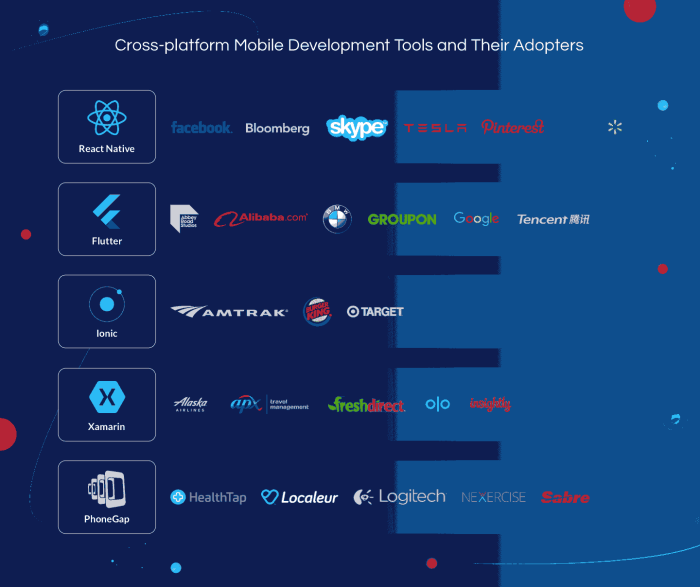Developing a Cross-Platform Strategy is like creating a killer mixtape for your business – it’s all about finding the right beats to reach your audience across different platforms and keep them jamming to your tune.
From defining what a cross-platform strategy is to exploring the benefits and challenges, this journey will equip you with the tools to rock the software development world.
Understanding Cross-Platform Strategy
In the realm of software development, a cross-platform strategy refers to the approach taken by companies to create applications or software that can run on multiple operating systems or platforms seamlessly. This strategy allows businesses to reach a wider audience and ensure a consistent user experience across different devices.
Having a cross-platform strategy is crucial for businesses in today’s digital landscape. It enables companies to maximize their reach by developing applications that cater to users on various devices such as smartphones, tablets, and desktop computers. By adopting a cross-platform approach, businesses can reduce development time and costs while maintaining a unified brand presence across different platforms.
Importance of Cross-Platform Strategy
- Increased Market Reach: By developing applications that are compatible with multiple platforms, businesses can tap into a larger audience base and expand their market reach.
- Cost-Effectiveness: Creating a single application that works across different platforms can be more cost-effective than developing separate apps for each platform.
- Consistent User Experience: A cross-platform strategy ensures that users have a consistent experience regardless of the device they are using, enhancing customer satisfaction and loyalty.
Examples of Successful Cross-Platform Strategies
1. Airbnb: The popular accommodation booking platform uses a cross-platform strategy to provide a seamless user experience on web browsers, iOS, and Android devices.
2. Netflix: Netflix has a strong cross-platform strategy that allows users to access their streaming service on a wide range of devices, including smart TVs, gaming consoles, and mobile devices.
3. Microsoft: Microsoft has embraced a cross-platform approach with products like Microsoft Office, which is available on Windows, macOS, iOS, and Android devices, ensuring widespread accessibility and usability.
Benefits of Developing a Cross-Platform Strategy

When it comes to developing a cross-platform strategy, there are numerous advantages that businesses can leverage to enhance their overall performance and reach. By implementing a cross-platform approach, companies can streamline their development process, increase their audience reach, and improve user experience across different devices and platforms.
Increased Reach and Visibility
- With a cross-platform strategy, businesses can reach a wider audience as their applications or services are accessible on multiple platforms such as iOS, Android, and web browsers.
- Increased visibility across different platforms can help companies attract new customers and retain existing ones by providing a consistent user experience.
- By targeting multiple platforms, businesses can maximize their market penetration and stay ahead of competitors who may be limited to a single platform.
Cost-Effectiveness and Efficiency
- Developing a single application that can run on multiple platforms can reduce development costs and time compared to creating separate apps for each platform.
- Maintenance and updates are easier with a cross-platform strategy, as changes can be applied across all platforms simultaneously, saving time and resources.
- Efficiency is improved as developers can focus on a single codebase, reducing the need for duplicate work and ensuring consistency across platforms.
Enhanced User Experience, Developing a Cross-Platform Strategy
- A cross-platform strategy can improve user experience by providing a seamless and consistent interface regardless of the device or platform used.
- Users can switch between devices without losing their progress or data, creating a more convenient and engaging experience.
- Consistent branding and design elements across platforms can strengthen brand identity and build customer loyalty.
Components of an Effective Cross-Platform Strategy: Developing A Cross-Platform Strategy
Developing a successful cross-platform strategy requires careful consideration of several key components that work together to ensure seamless integration and optimal performance across different platforms.
1. Consistent User Experience
One of the most important components of a cross-platform strategy is to maintain a consistent user experience across all platforms. This includes ensuring that the design, functionality, and features are uniform regardless of whether the user is accessing the platform on a desktop, mobile device, or tablet.
2. Seamless Data Integration
Another essential component is seamless data integration. This involves ensuring that data can be easily transferred and synchronized across different platforms to provide users with a cohesive experience. Tools like Firebase, AWS Amplify, and Microsoft Azure can be used to streamline data integration processes.
3. Scalable Architecture
An effective cross-platform strategy should also incorporate a scalable architecture that can accommodate growth and changes in user demand. Technologies like React Native, Xamarin, and Flutter are popular choices for building scalable cross-platform applications.
4. Performance Optimization
Performance optimization is crucial for ensuring that the application runs smoothly and efficiently on all platforms. Tools like NativeScript, Ionic, and PhoneGap can help optimize performance by leveraging native device capabilities and optimizing code for each platform.
5. Alignment with Business Goals
Aligning the cross-platform strategy with business goals is paramount for success. This involves identifying key objectives, target audiences, and desired outcomes, and tailoring the strategy to meet these goals effectively. By aligning the strategy with business objectives, companies can maximize ROI and achieve sustainable growth.
Challenges in Developing a Cross-Platform Strategy

Developing a cross-platform strategy comes with its own set of challenges that organizations need to address in order to ensure successful implementation. From compatibility issues to resource management, navigating these obstacles is crucial for a seamless cross-platform development process.
Compatibility Issues Across Platforms
One of the most common challenges in developing a cross-platform strategy is ensuring compatibility across different platforms. Each platform has its own set of requirements, features, and limitations, making it difficult to create a unified experience for users. To overcome this challenge, developers can utilize tools and frameworks that help streamline the development process and ensure consistency across platforms.
Managing Resources and Timelines Effectively
Another key challenge in cross-platform development is managing resources and timelines effectively. Balancing the needs of multiple platforms, coordinating with different teams, and ensuring timely delivery of updates can be a daunting task. To address this challenge, organizations can implement agile project management methodologies, prioritize tasks based on impact and urgency, and allocate resources strategically to meet deadlines efficiently.
